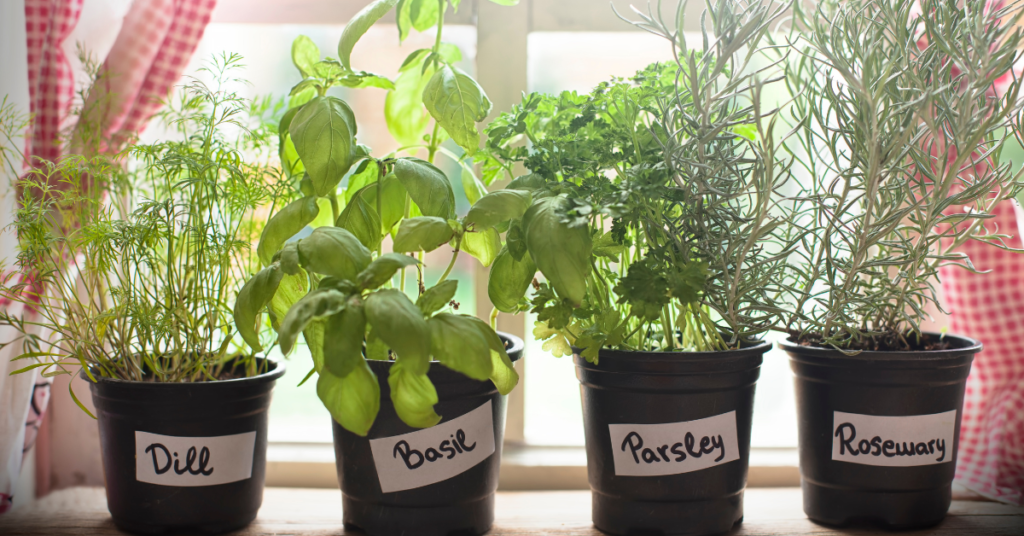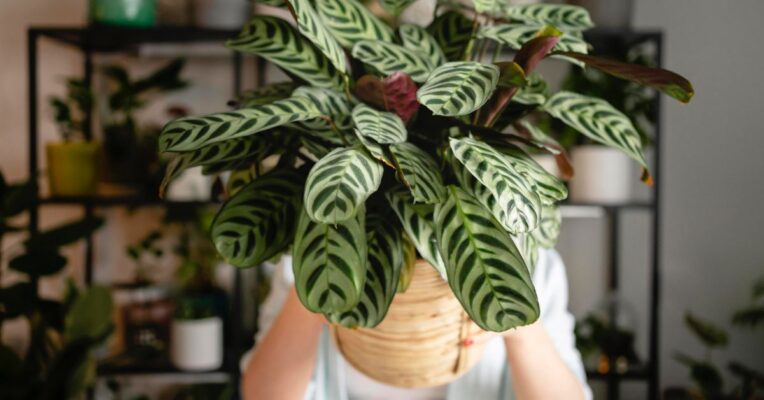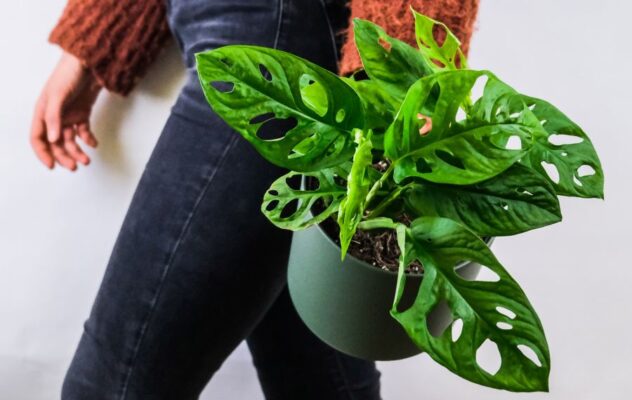Monstera Deliciosa is a worldwide trending plant; not just amongst plant lovers but its unique leaves have been used as inspiration for designers, painters, jewellery makers (hello, monstera earrings!), and interior designers too. With its rapid popularity around its laser-cut leaves, it has mistakenly been called Split Leaf Philodendron but it’s not the same; in fact the monstera is its own species and isn’t from the philodendron family at all.
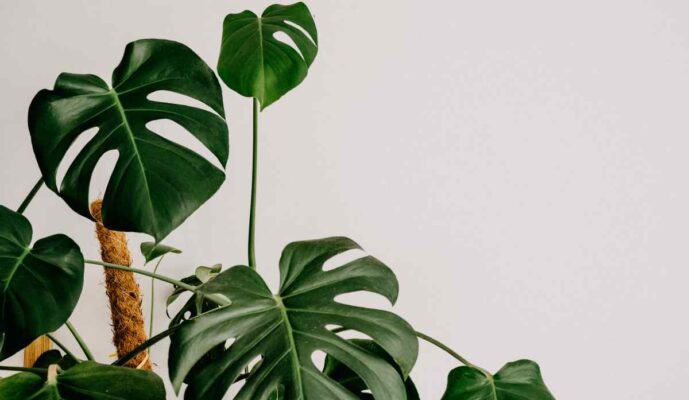
If you’ve been thinking about adding these plants to your home, get to know your plants so you can tell the difference. With all the confusion, it’s not uncommon to find the two plants mislabeled in plant centres and nurseries too. Here’s a look at some of their key differences and care needs.
Disclaimer: This post may contain affiliate links. This means we may earn a commission from any purchase you make via the links but at no extra cost to you 🙂
Split Leaf Philodendron vs Monstera Deliciosa – What’s the Difference?
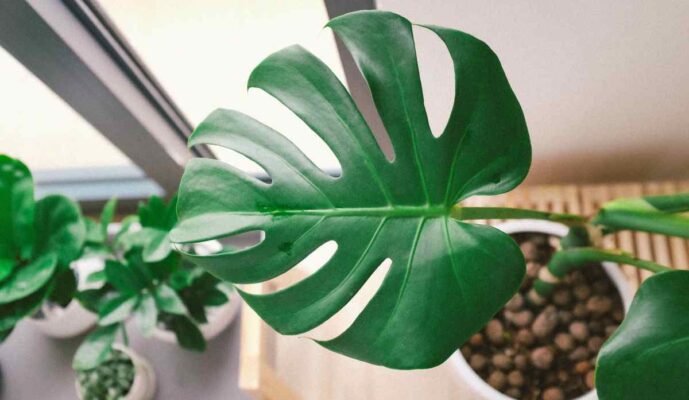
Origin
The Split Leaf Philodendron is native to Central and South America, particularly Brazil, Bolivia, Paraguay and Argentina while the Monstera Deliciosa and the entire monstera family originates from the tropical rainforests of Southern Mexico and Panama.
Size of Mature Plant
Today, both plants thrive as common houseplants and their sizes are controllable to adapt to indoor conditions. However, considering they originated from rainforests, it’s no surprise that these are some serious big boy plants!
The Split Leaf Philodendron can reach a whopping 20 feet in optimal conditions while Monstera Deliciosa is known to grow to 10 feet as a mature plant.
Leaf Appearance
Here’s where things can get confusing if you’re not familiar with both plant species. The conversation of Split Leaf Philodendron vs Monstera Deliciosa occurs because their leaves are thought to be the same because they both seem to have holes. However, their ‘tears’ are different, here’s how:
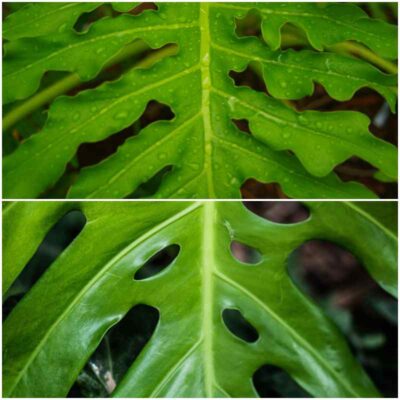
Split Leaf Philodendron leaves are just as its name suggests, split. Their leaves naturally grow with finger-like segments, giving it a ruffled look and feel. There are no holes on the leaves.
Monstera Deliciosa has uneven splits and holes or what is known as fenestrations. This means the splits and holes occur as the leaf matures. There are several theories as to why this happens, the most common being that the plant is native to low-light areas and the holes allow light to reach the bottom of the plant.
It’s also suggested that the holes add to the strength of the leaves, allowing it to withstand harsh winds from hurricanes and tornadoes.
Growth Features
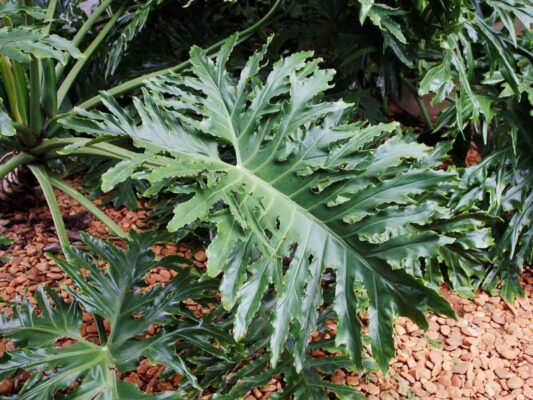
While the two plants look the same, one key difference in the Split Leaf Philodendron vs Monstera Deliciosa is how the plant grows. Split Leaf Philodendrons is the wild child between the two. It grows quickly and grows outwards and upwards and can easily become an invasive species grown outdoors, directly in the ground.
On the other hand, Monstera Deliciosa grows slower in comparison and is a natural climber. In the wild, this means it borrows support and grows on tree trunks or other sturdy plants. As an indoor plant, it will require a support pole such as a moss pole to thrive and reach its optimal height. Without a moss pole, you might notice the sturdy stems falling over and the plant experiencing stunted growth.
If you’re looking for a houseplant or something to add to your indoor plant collection, I recommend getting this the items below as a complete set:
- Monstera Deliciosa plant
- Support pole – not entirely necessary with young plants but staking it early helps navigate a healthy upward growth vs bent branches that may be weak
- Good quality soil. Below are two great options:
Fruiting Habits
Did you know the Monstera Deliciosa plant is a fruiting species? The word ‘deliciosa’ meaning delicious Spanish is in reference to its fruit! Many people didn’t know of its fruiting nature since production is rare and the plant requires specific and optimal conditions to bear fruit. It’s only found in the wild and within its country of origin. The monstera fruit looks like corn and tastes a little bit like if a pineapple and banana had a fruit-child.
On the other hand, Split Leaf Philodendrons don’t bear fruit. To populate, the plant is able to flower but that is rare and is poisonous for consumption.
How do I care for Split Leaf Philodendron vs Monstera Deliciosa?
Both plants have almost similar native growth habitats so their care is almost the same. They require light, airy soil, indirect sunlight and should be watered when the top inch of the soil is dry. Here’s a quick side-by-side comparison.
| Feature | Philodendron Split Leaf | Monstera Deliciosa |
| Water requirements | Loves moisture, water when top is dry | Let it dry out and water thoroughly |
| Soil preference | Well-draining | well-draining |
| Light requirement | Indirect light | Indirect light & can tolerate low-light conditions |
| Care expertise | Suitable for beginners | Suitable for beginners |
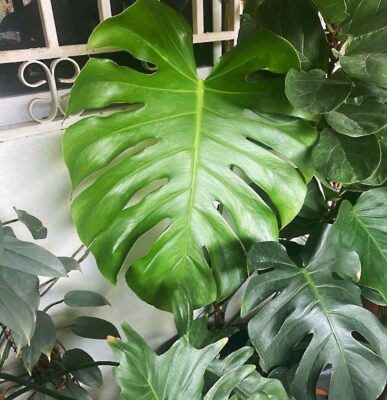
Which is better Split Leaf Philodendron or Monstera Deliciosa?
Personally, I think they’re both fantastic and the choice depends on your aesthetic preference. They both have similar care requirements and produce big leaves, giving you that lovely jungle feel indoors.
However, Monstera’s are more commonly found indoors because they’re neater in appearance and have become a crowd favorite while Philodendrons are trailing plants and if not pruned or neglected, can appear unruly.
If you can’t decide, I’d recommend starting with the Monstera only because it’s cheaper and then getting the Split Leaf after as a second, third, twentieth plant!
How do I tell the difference between Split Leaf Philodendron vs Monstera Deliciosa?
Observe the leaves. Monsteras have holes and splits on the edges while Philodendrons don’t have holes and have even finger-like splits on all leaves regardless if they’re young, new leaves or mature leaves.
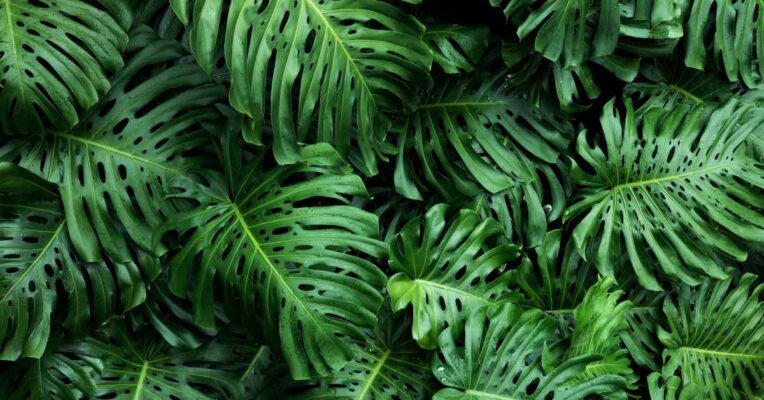
Is my plant a Monstera or Philodendron?
If you don’t have both plants side-by-side to do a comparison, it’s hard to tell the difference. Is your plant a philodendron that looks like monstera or a monstera that looks like a philodendron? If you’re keen to know for sure, look for the key indicators to tell if you have a Monstera or Philodendron.
A Monstera grows upwards and its leaves have fenestrations which look like holes and split edges that aren’t uniformed. If you plants leaves have even finger-like splits all the way through, it’s likely a Split Leaf Philodendron.
Are there benefits to having a Split Leaf Philodendron or Monstera Deliciosa?
There are a ton of benefits to have both or either plants at home. They improve the quality of the air, boost your moods, assist with mental health and so much more. Read about the 10 benefits of indoor plants here.
Are monstera plants toxic to dogs?
Both monstera and philodendron plants are toxic to pets and humans if consumed. They’re safe to touch, handle and be around but all parts of the plant should not be consumed. It’s generally safe around humans but if your cats and dogs are mischievous and curious, it might not be the best option for you.
It’s a leafy wrap up
There’s no right or wrong when it comes to choosing indoor plants, it’s just trial and error so if you’re unsure of which to get, get both and see which you like better!
